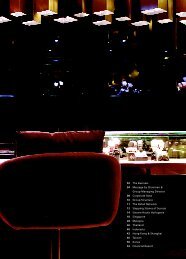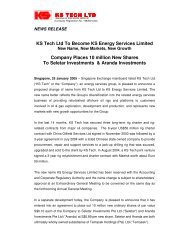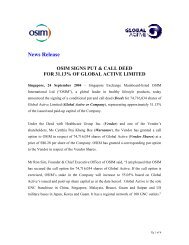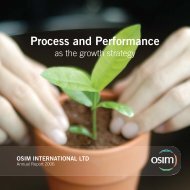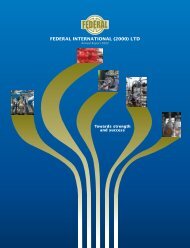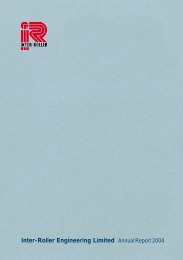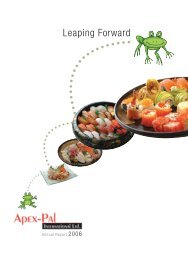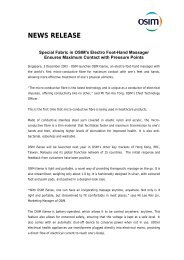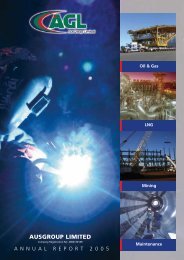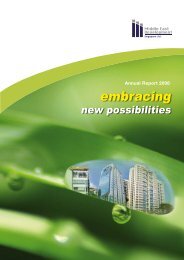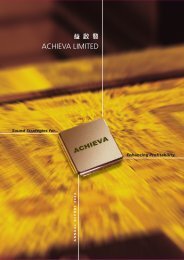HYFLUX LTD AND SUBSIDIARIES
HYFLUX LTD AND SUBSIDIARIES
HYFLUX LTD AND SUBSIDIARIES
Create successful ePaper yourself
Turn your PDF publications into a flip-book with our unique Google optimized e-Paper software.
NOTES TO THE FINANCIAL STATEMENTS (CONTINUED)<br />
FOR THE YEAR ENDED 31 DECEMBER 2002<br />
02. SIGNIFICANT ACCOUNTING POLICIES (CONTINUED)<br />
(C)<br />
<strong>SUBSIDIARIES</strong> <strong>AND</strong> ASSOCIATED COMPANIES<br />
Investments in subsidiaries and associated companies are stated in the financial statements of the Company at cost.<br />
Provision is made where there is a decline in value that is other than temporary.<br />
A subsidiary is a company in which the Group, directly or indirectly, holds more than half of the issued share capital,<br />
or controls more than half of the voting power, or controls the composition of the board of directors.<br />
An associated company is a company, not being a subsidiary, in which the Group has an interest of not less than 20%<br />
of the equity and in whose financial and operating policy decisions the Group exercises significant influence.<br />
(D)<br />
LONG-TERM INVESTMENTS<br />
Investments held for long-term purposes are stated at cost. Provision for impairment for long-term investments is<br />
made when there is a decline, other than temporary, in value of the investments.<br />
(E)<br />
FIXED ASSETS<br />
Fixed assets are stated at cost, net of depreciation and any impairment loss. The cost of an asset comprises its<br />
purchase price and any directly attributable costs of bringing the asset to working condition for its intended use.<br />
Expenditure for additions, improvements and renewals are capitalised and expenditure for maintenance and repairs<br />
are charged to the profit and loss account. When assets are sold or retired, their cost and accumulated depreciation<br />
are removed from the financial statements and any gain or loss resulting from their disposal is included in the profit and<br />
loss account.<br />
Depreciation is provided on all fixed assets at the following rates to write off the cost, less estimated residual value of<br />
each asset on a straight-line basis over their estimated useful lives:<br />
Plant and machinery<br />
Motor vehicles<br />
Computers<br />
Office equipment<br />
Leasehold properties and improvements<br />
Furniture and fittings<br />
Renovation<br />
4 - 5 years<br />
4 - 5 years<br />
1 - 4 years<br />
4 - 5 years<br />
Over the lease period<br />
4 - 10 years<br />
4 - 5 years<br />
Construction-in-progress represents buildings and plants under construction and is stated at cost. This includes cost<br />
of construction, plant and equipment and other direct costs. Construction-in-progress is not depreciated until such<br />
time as the relevant assets are completed and put into operational use.<br />
(F)<br />
INTANGIBLES<br />
(I) INTELLECTUAL PROPERTY RIGHTS<br />
The initial cost of acquiring intellectual property rights is capitalised and amortised on a straight-line basis<br />
over the period of their expected benefits, which normally does not exceed 5 years.<br />
(II)<br />
RESEARCH <strong>AND</strong> DEVELOPMENT EXPENDITURE<br />
Research and development costs are charged against income in the period incurred except for development<br />
costs that are expected to have future benefits. Development costs that have been capitalised are amortised<br />
on a straight-line basis over the period of their expected benefits, which normally does not exceed 5 years.<br />
(III)<br />
LICENSING FEES<br />
The initial cost of acquiring licenses is capitalised and amortised on a straight-line basis over the period of<br />
the licensing agreement.




